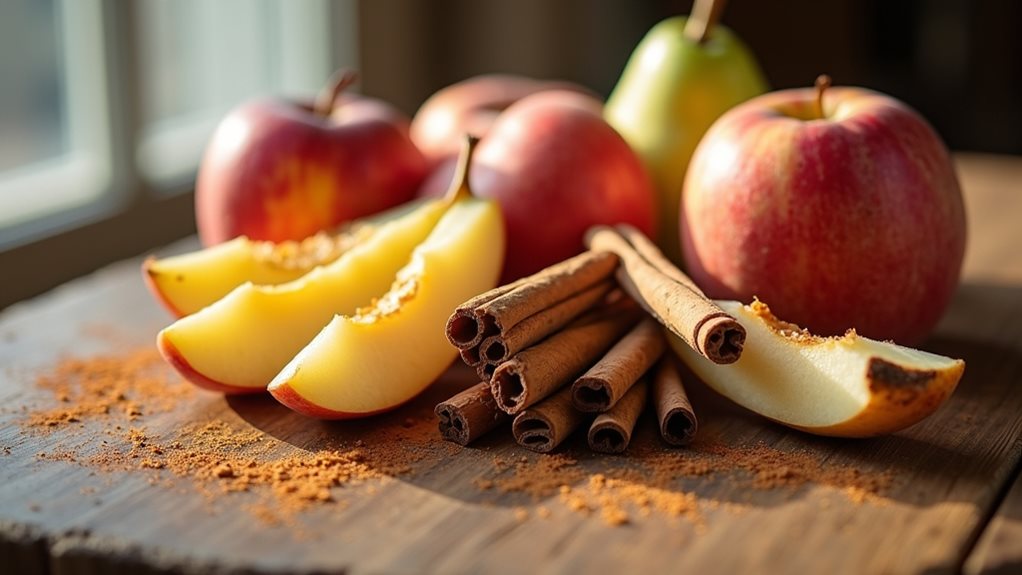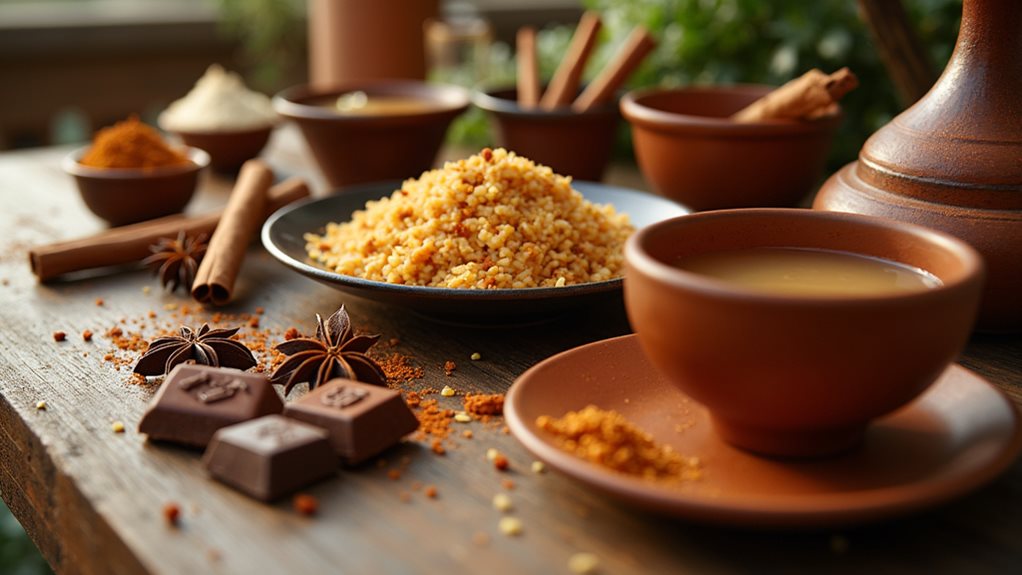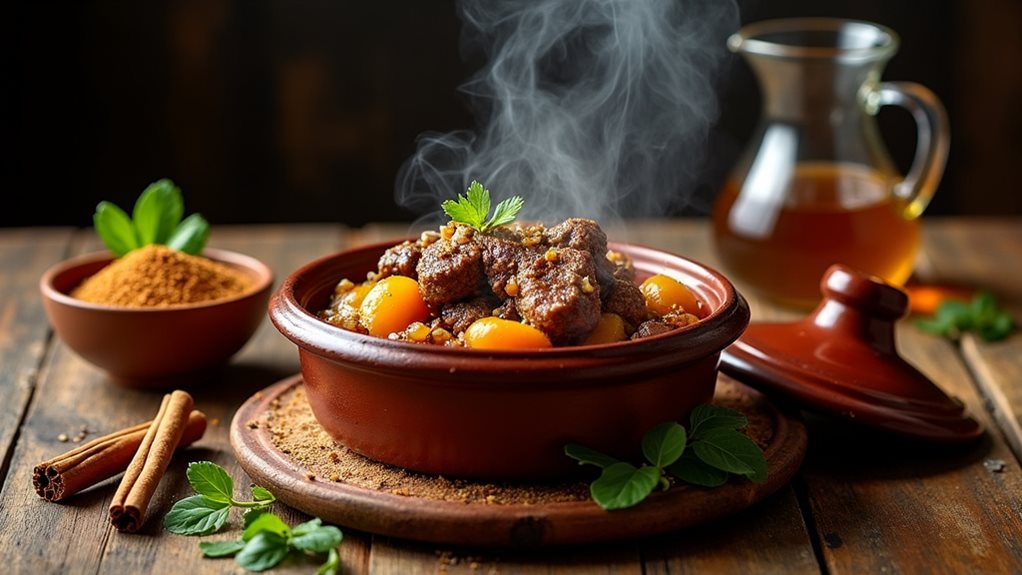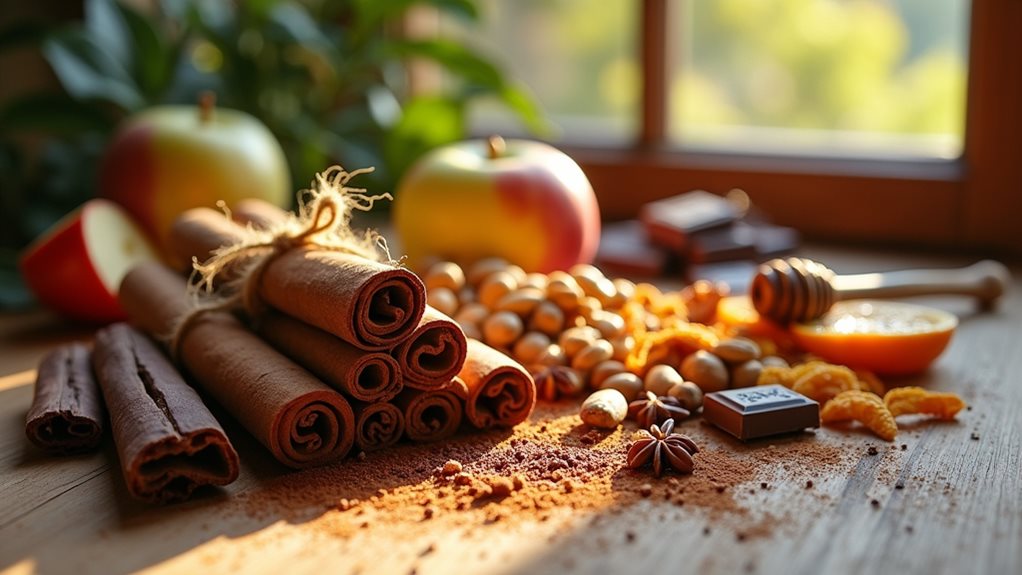Cinnamon pairs beautifully with apples, pears, and stone fruits for sweet applications, while complementing savory dishes containing sweet potatoes, squash, and carrots. You'll enhance cinnamon's warmth by combining it with nutmeg, cloves, ginger, or cardamom in a 4:1 ratio. Try it in global cuisine applications like Moroccan tagines, Indian curries, Mexican chocolate, or Greek moussaka. Each cinnamon variety offers distinct notes—Ceylon provides delicate citrus undertones while Cassia delivers bold, spicy character. The perfect pairing awaits your next culinary adventure.
Cinnamon and Fresh Fruits: Classic Sweet Combinations

While many spices can enhance fruit flavors, cinnamon stands out as perhaps the most versatile companion to fresh fruits, creating harmonious combinations that have stood the test of time.
You'll find that pairing cinnamon with strawberries, blueberries, and pineapple in cinnamon fruit salads creates a natural dressing as the spice draws out the fruits' juices. This warm, aromatic spice balances the natural sweetness of peaches, pears, and apples while adding depth to their flavor profiles. The combination creates a perfect balance between sweetness and spice that tantalizes the taste buds.
Try experimenting with unexpected pairings like cinnamon and kiwi or cinnamon dessert toppings sprinkled over grilled pineapple. Consider reading your recipes aloud as this can help catch errors and ensure your flavor descriptions sound as delicious as the combinations will taste, since reading aloud often reveals nuances missed during silent review.
The contrast between cinnamon's warmth and the fruits' juicy sweetness works particularly well in both summer treats and autumn desserts.
Complementary Spices That Enhance Cinnamon's Warmth
While cinnamon's distinctive warmth stands beautifully on its own, pairing it with complementary spices can elevate your culinary creations to new heights.
Nutmeg offers a sweet, nutty synergy that deepens cinnamon's profile, while ginger brings a zesty balance that cuts through cinnamon's intensity with bright, peppery notes. Turmeric partners excellently with cinnamon, adding a citrusy aroma that brightens curries, soups, and rice dishes.
Clove's aromatic depth, with its intense, almost numbing quality, creates a powerful triumvirate when combined with cinnamon, appearing in everything from holiday baking to savory marinades. For meat dishes specifically, cinnamon creates flavor harmony when paired with spices like cumin or clove, resulting in more complex and satisfying flavor profiles.
Nutmeg's Sweet Synergy
Few spice combinations create such harmonious depth as nutmeg and cinnamon working in tandem. When you're seeking to elevate your culinary creations, understanding nutmeg benefits becomes essential—it provides a nutty, slightly sweet foundation that perfectly complements cinnamon's woody warmth.
The most successful nutmeg applications include holiday baking, where a 1:4 ratio of nutmeg to cinnamon creates balanced complexity. Cinnamon's more dominant flavor can overshadow nutmeg if proportions aren't carefully measured. The spice adds warm sweetness to dishes while enhancing their depth and richness when used in small amounts.
You'll find this duo excels in pumpkin pie, eggnog, and warm beverages like mulled wine and spiced cider. For savory innovation, try incorporating both spices in sweet potato casseroles or braised duck breast sauces.
Remember that nutmeg can enhance without overpowering when used judiciously. For maximum freshness and flavor control, consider grating whole nutmeg rather than using pre-ground varieties.
Ginger's Zesty Balance
Among the most vibrant companions to cinnamon, ginger brings an invigorating zesty quality that perfectly balances cinnamon's warm embrace.
When you're crafting recipes with these complementary spices, you'll reveal both exceptional flavor and ginger health benefits, including anti-inflammatory properties and digestive support. Consider using the herb layering technique to achieve complex flavor profiles when combining these spices in your sauces.
The culinary uses of ginger alongside cinnamon create magic in:
- Warming chai blends where cardamom and cloves amplify their aromatic intensity
- Rich curries and tagines where they form the backbone of complex flavor profiles
- Innovative smoothies combining banana and apple with these warming spices
- Traditional spice blends like pumpkin pie and berbere that showcase their perfect harmony
This dynamic duo works synergistically, enhancing each other's properties while creating depth that neither achieves alone. For those seeking these spices, both ginger powder and Ceylan cinnamon are readily available online at competitive prices. Cocktail enthusiasts particularly enjoy how these spices create fiery flavor profiles in drinks like the Scotch and Ginger Beer.
Clove's Aromatic Depth
Cloves stand as perhaps the most natural companion to cinnamon in the culinary world, creating a profound aromatic synergy that's greater than the sum of its parts.
When you're seeking to deepen cinnamon's warmth, a clove infusion provides that perfect pungent counterpoint, transforming ordinary recipes into multidimensional experiences.
You'll find this powerful duo starring in global cuisines, from holiday baking traditions to savory Middle Eastern and Indian dishes.
The aromatic balance they achieve works exceptionally well in slow-cooked applications—try adding both to your next braised meat dish or hearty stew.
For beverages, float a cinnamon stick with a few whole cloves in mulled wine or apple cider to experience their full aromatic potential.
This ancient pairing continues to prove its relevance in contemporary cooking, especially when using Ceylon cinnamon with its floral and citrus notes that complement cloves perfectly.
Like the dynamic combination of cinnamon and cloves, pairing cinnamon with chili powder delivers an incredible contrast of cozy fall flavors that works beautifully in both sweet and savory applications.
Sweet Ingredients That Elevate Cinnamon Flavors
Cinnamon's warm, aromatic profile becomes truly exceptional when paired with the right sweet companions.
Whether you're crafting cinnamon desserts or innovative cinnamon beverages, select ingredients that amplify its distinctive character while creating harmonious flavor combinations.
Try these transformative pairings to elevate your cinnamon creations:
- Vanilla and brown sugar create a foundational sweetness that allows cinnamon's complexity to shine without overwhelming it.
- Caramel and honey introduce rich, amber notes that deepen cinnamon's warm undertones.
- White chocolate and mascarpone offer creamy backdrops that soften cinnamon's intensity.
- Fruits like apple, banana, and fig provide natural sweetness and moisture that carry cinnamon's spice throughout your creation.
Global Cuisines Featuring Distinctive Cinnamon Applications

Across diverse culinary traditions, cinnamon transcends its reputation as merely a sweet spice, appearing in savory dishes, baked goods, beverages, and ceremonial foods worldwide.
You'll find unique cinnamon applications in Indian biryani, where it creates depth alongside other warming spices, and in Moroccan tagines, where it enriches slow-cooked stews. Mexican cuisine pairs cinnamon with chili in savory dishes and hot chocolate, while Greek moussaka and Turkish baklava showcase its versatility.
For innovative cinnamon pairings, look to Chinese five-spice powder in stir-fries and roasted meats.
Beyond savory applications, explore cinnamon in Spanish churros, American snickerdoodles, and European mulled wine. During holidays, this adaptable spice enhances Christmas desserts, Ramadan sweets, and Thanksgiving pies, proving its global culinary significance.
Different Cinnamon Varieties and Their Unique Flavor Profiles
Where your cinnamon comes from markedly affects the flavor it brings to your dishes, with each variety offering distinct aromatic profiles and intensity levels.
You'll notice that Ceylon cinnamon provides delicate, citrusy notes perfect for subtle desserts, while the bolder Cassia, Saigon, and Korintje varieties deliver varying degrees of spicy warmth better suited for heartier recipes.
These regional differences mean you can select the perfect cinnamon type based on whether you're preparing a light custard requiring Ceylon's subtlety or a rich holiday spice cake that benefits from Saigon's robust character.
Source Matters Most
Though many home cooks reach for whatever cinnamon happens to be in their pantry, the specific variety you choose can dramatically transform your culinary creations.
Cinnamon sourcing directly impacts quality and flavor intensity, with each type offering distinct characteristics that can elevate your dishes from ordinary to extraordinary.
When selecting cinnamon for your next recipe, consider these distinct varieties and their applications:
- Ceylon – delicate and citrusy, perfect for milk-based desserts and European pastries
- Cassia – bold and versatile, ideal for American-style baking and savory applications
- Saigon – intensely spicy with high oil content, excellent for Vietnamese dishes
- Korintje – balanced sweetness, well-suited for Indonesian cuisine and fruit desserts
Understanding these differences allows you to strategically pair cinnamon varieties with complementary ingredients, creating more sophisticated flavor profiles in your innovative cooking.
Regional Taste Differences
While most casual cooks might view cinnamon as a singular spice, the geographical origin of this aromatic bark creates dramatic differences in flavor that can transform your culinary creations.
The four main cinnamon varieties each offer distinct profiles: Ceylon's delicate, citrusy notes shine in Asian and Mexican dishes; Cassia's bold, musky character dominates North American recipes; Saigon's intense spiciness elevates Southeast Asian cuisine; and Korintje's sweet-earthy balance enriches Indonesian and Dutch baking.
These regional preferences aren't arbitrary—they've evolved through centuries of culinary tradition.
You'll notice Ceylon's subtlety complements delicate desserts, while Saigon's higher volatile oil content makes it perfect for robust savory applications.
Savory Dishes Where Cinnamon Creates Unexpected Depth

Despite cinnamon's reputation as a sweet spice dominating desserts and breakfast treats, it shines surprisingly well in savory applications where its warm, aromatic qualities create remarkable depth and complexity.
You'll find cinnamon meat dishes across cultures, from Moroccan lamb tagines to Vietnamese pho, where it transforms ordinary proteins into memorable meals.
Cinnamon vegetables and grains also benefit from this versatile spice.
Try incorporating it into your savory cooking with these approaches:
- Slow-cook lamb shanks with cinnamon sticks for a Middle Eastern-inspired meal
- Add a pinch to roasted sweet potatoes or carrots for unexpected warmth
- Incorporate into rice pilaf alongside almonds and cardamom
- Blend into chili powder for Mexican dishes with subtle sweetness
Many home cooks add cinnamon to their slow cooker chili for enhanced flavor that develops beautifully during the long cooking process.
Frequently Asked Questions
Is Cinnamon Safe for Dogs to Consume?
Yes, cinnamon is safe for dogs in small amounts. You'll want to follow cinnamon dosage guidelines—less than one teaspoon. It offers dog health benefits including anti-inflammatory properties, but always consult your vet first.
How Long Does Ground Cinnamon Maintain Its Potency?
You'll find ground cinnamon maintains peak potency for about 1 year. For ideal spice freshness, store it in airtight glass containers away from light and heat. Proper cinnamon storage greatly extends its aromatic lifespan.
Can Cinnamon Help Regulate Blood Sugar Levels?
Yes, cinnamon can help regulate your blood sugar levels by enhancing insulin sensitivity and improving metabolism. It's shown to reduce glucose spikes by up to 29% when you consume 1-6 grams daily as a complementary approach.
Are There Any Allergic Reactions Associated With Cinnamon?
Yes, you can develop cinnamon allergies or cinnamon sensitivity. Reactions range from skin irritation and breathing difficulties to digestive issues. In rare cases, you'll experience severe reactions like anaphylaxis requiring immediate medical attention.
What's the Difference Between Cinnamon Sticks and Ground Cinnamon?
Like a typewriter in a smartphone era, cinnamon sticks and ground cinnamon differ fundamentally. You'll find sticks last longer and infuse beverages slowly, while ground cinnamon varieties blend instantly into your innovative baking and diverse culinary uses.
Final Thoughts
Whether you're baking with apples or seasoning a Moroccan tagine, cinnamon's versatility makes it a kitchen powerhouse. You'll find that "variety is the spice of life" when exploring its countless flavor pairings. From sweet chocolate to savory meats, each combination offers a new dimension to this ancient spice. Don't hesitate to experiment beyond traditional uses—your culinary adventures with cinnamon might surprise even the most experienced palate.















